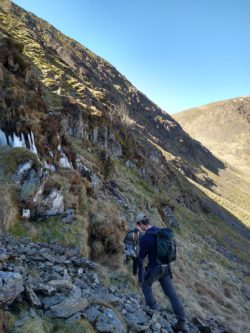Mountain flora expedition to Glenridding
"MOUNTAIN FLORA EXPEDITION TO GLENRIDDING COMMON" By Tasmin Fletcher, Project Assistant, May 2021
Much though I love Hardknott, one thing I’ve really missed over lockdown is being able to travel around and see what other interesting environmental work is being done around the Lakes, and further afield. So I was pretty excited when we were finally able to take a long-anticipated trip to the John Muir Trust’s (JMT) site at Glenridding.
John, Craig and I had been invited by Isaac Johnston, the Glenridding Conservation Officer, to come and collect cuttings of a rare montane willow species called tea-leaved willow, which can be found on the isolated ledges of Catstycam’s northern flank. This species, along with several others, is a component of montane woodland found at high elevations across the British Isles. Once widespread, this habitat is now very rare, especially in England, with remnant individual trees and other plants in isolated and inaccessible spots where they have escaped browsing by sheep and deer.
Isaac had booked the sun for us and we headed up towards the fells, joined by Pete Barron, the site’s Property Manager. As we gained height, we dipped into the shadow of the mountain. Despite the sunshine, the north facing slopes still had patches of ice glistening across the crags and frozen moss crunched beneath our feet. Isaac explained that the alpine plants that are found here actually prefer this dark, damp and drippy corner, as the steep gradient means south or west facing areas would dry out too quickly for the plants to survive.
Isaac and Pete made a bee-line for the tea-leaved willow, this particular tree being well documented and monitored for a number of years now. Our intention was to take some small cuttings which could then be propagated, providing us with young trees of this upland specialist which should be right at home on the slopes of Harter Fell at Hardknott. John did the honours, cutting an branch from the willow perched on a not-at-all precarious ledge…
Following successful acquisition of the cuttings (and less successful attempts to revive my numb fingers), Isaac lead us on across the craggy slopes in search of interesting upland flora. Isaac and Pete have been working to increase the diversity of alpine plant species here, so as well as indigenous relic plants we also found some which had been grown by volunteers from local seed and planted out. One of the most iconic plants still found on these ledges is roseroot, identified by the clumps of tentacle-like roots tipped with pink dangling below the ledges they cling to. We also found starry saxifrage, angelica, alpine lady’s mantle, burnet’s saxifrage and greater woodrush, along with planted specimens of water avens, globeflower, aspen and dwarf willow (on a side note, I absolutely love the wonderfully poetic common names of these montane species!).
Unfortunately, it still being April, we were a bit early to appreciate the flowers in all their glory - late summer being the best time for flowers at this altitude. However, one exception to this was the purple saxifrage. Vivid and delicate, these tiny flowers were just coming into their own, and found in particular abundance dotted across the spoil heaps of the nearby old lead mine. Beautiful!
With Craig getting side-tracked exploring the old mineshaft and Isaac’s enthusiasm to show us the diversity of plants on the site, the afternoon wore on until it was time to head back down to the car.
We carefully transported our tea-leaved willow cutting home and potted it up – we’re keeping our fingers crossed that it grows ok! We also have seeds donated by Isaac and Pete for other flowering plants (including species I mentioned above) which have been sown by our growing group, and we look forward to planting these up at Hardknott too.
I think I speak for all three of us in saying I couldn’t have asked for a better first trip out after lockdown!
Further reading on mountain plants and woodland:
Scott, M., 2000, Montane Scrub, Natural Heritage Management Series, SNH
Plantlife: Lake District Important Plant Area
Mountain Flowers by Michael Scott (Bloomsbury 2016)





